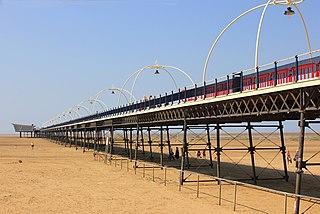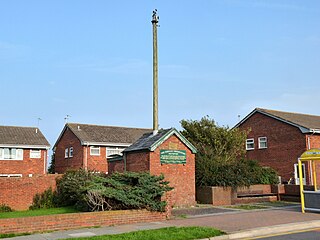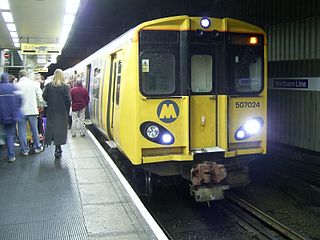
The Metropolitan Borough of Sefton is a metropolitan borough of Merseyside, England. It was formed on 1 April 1974, by the amalgamation of the county boroughs of Bootle and Southport, the municipal borough of Crosby, the urban districts of Formby and Litherland, and part of West Lancashire Rural District. It consists of a coastal strip of land on the Irish Sea which extends from Southport in the north to Bootle in the south, and an inland part to Maghull in the south-east, bounded by the city of Liverpool to the south, the Metropolitan Borough of Knowsley to the south-east, and West Lancashire to the east.

Southport is a seaside town in the Metropolitan Borough of Sefton in Merseyside, England. At the 2001 census, it had a population of 90,336, making it the eleventh most populous settlement in North West England.

Formby is a town and civil parish in the Metropolitan Borough of Sefton, Merseyside, England, which had a population of 22,419 at the 2011 Census.

Marshside is a suburb of the town of Southport, Merseyside, England. It is part of the ancient parish of North Meols and was formerly a detached settlement, on the northern fringe of what is now Southport.

Churchtown is a suburb of Southport, Merseyside, England. Historically in Lancashire, it is surrounded by Crossens, High Park and Marshside in the ancient parish of North Meols on the northern fringe of what is now Southport.

Southport is a constituency in Merseyside which has been represented in the House of Commons of the UK Parliament since 2017 by Damien Moore of the Conservative Party.

Meols Cop railway station serves the Blowick suburb of the coastal town of Southport, Merseyside, England. The station has an island platform and is served by Northern Trains‘ Manchester Victoria/Manchester Piccadilly - Southport via Wigan Wallgate branch services, on which it is the last stop before the terminus.

The Merseyrail Northern line is a cross-city railway running from Hunts Cross in south Liverpool then to termini in the north at Southport (Merseyside), Ormskirk (Lancashire) and Kirkby (Merseyside). It and the Wirral Line are commuter rail services operated by Merseyrail, serving Merseyside. A third line, the City Line, is not owned or operated by Merseyrail, although stations inside Merseytravel's area are branded as Merseyrail. All three lines are funded by Merseytravel.
North Meols is a civil parish and electoral ward in the West Lancashire district of Lancashire, England. The parish covers the village of Banks and the hamlet of Hundred End. The population of the parish/ward at the 2011 census was 4,146. Historically the parish covered a wider area including much of what is now Southport.

Banks is a large coastal village in Lancashire, England, south of the Ribble estuary four miles (6 km) north-east of Southport. The village is administered by West Lancashire Borough and North Meols Parish Council. It is in the South Ribble parliamentary constituency. At the 2001 census the population of the North Meols civil parish was 3,792, rising to 4,146 by the 2011 census.

Sefton Council is the governing body for the Metropolitan Borough of Sefton in the county of Merseyside, north-western England. The council was under no overall control from the 1980s until 2012 when the Labour Party took control. It is a constituent council of Liverpool City Region Combined Authority.

Meols Hall is a historical manor house in Churchtown, Merseyside, dating from the 12th century with a 16th-century tithe barn restored for wedding receptions and ceremonies.

Kew is a suburb and ward of Southport, a seaside town in Sefton, Merseyside, England. It makes up the southeastern edge of the town, bordering Scarisbrick in West Lancashire. It is a middle class area of mostly modern development, and one of Southport's smallest suburbs.

St Cuthbert's Church is an Anglican church in Churchtown, Merseyside, a village that is now a suburb of Southport in the English county of Merseyside. It is an active parish church in the Diocese of Liverpool and the archdeaconry of Warrington. It has been designated a Grade II listed building by English Heritage. Historically, St Cuthbert's was the parish church of the ecclesiastical parish of North Meols and was within the boundaries of the historic county of Lancashire.
High Park is a suburb of Southport, Merseyside, England. It is located on the eastern fringe on the town, just south of Churchtown. High Park Road is within the area of Sefton Metropolitan Borough Council Council who provide services such as refuse collection and are responsible for the collection of council tax.

Hesketh Park is a public park situated near the north end of Lord Street in the Victorian seaside town of Southport, Merseyside, England. It was designed as a public park in the mid-19th century by Edward Kemp, and was further developed in the 20th century. The land was donated by the Rev Charles Hesketh and has many Victorian features and landscape designs.
Southport station may refer to:
Churchtown is a district to the north of Southport, Sefton, Merseyside, England. It contains 84 buildings that are recorded in the National Heritage List for England as designated listed buildings. Of these, one is listed at Grade II*, the middle of the three grades, and the others are at Grade II, the lowest grade.


















